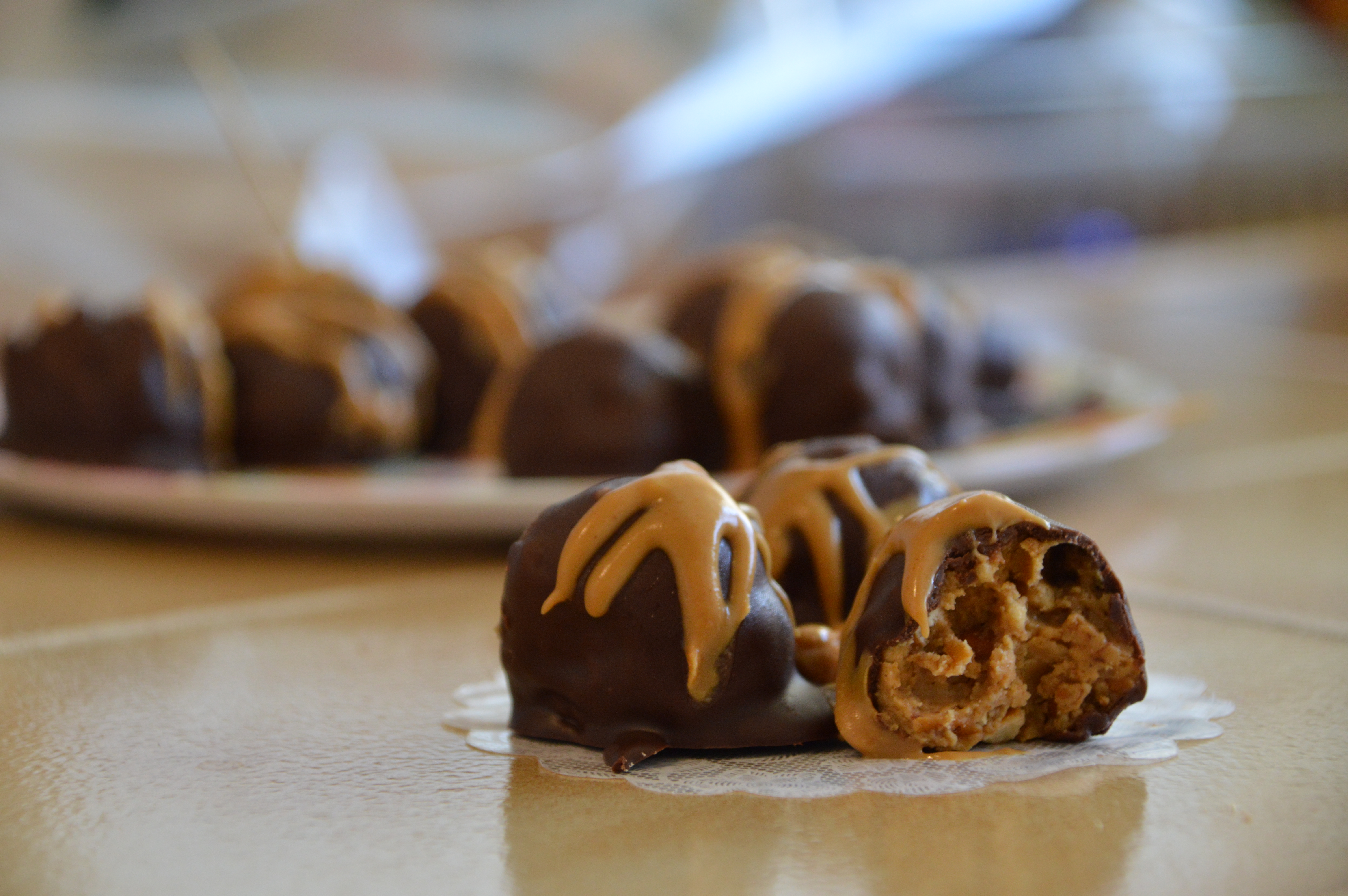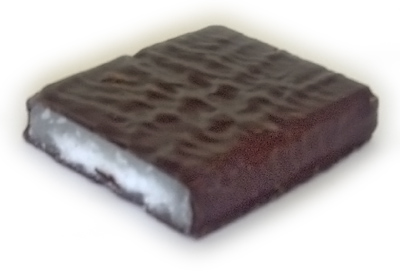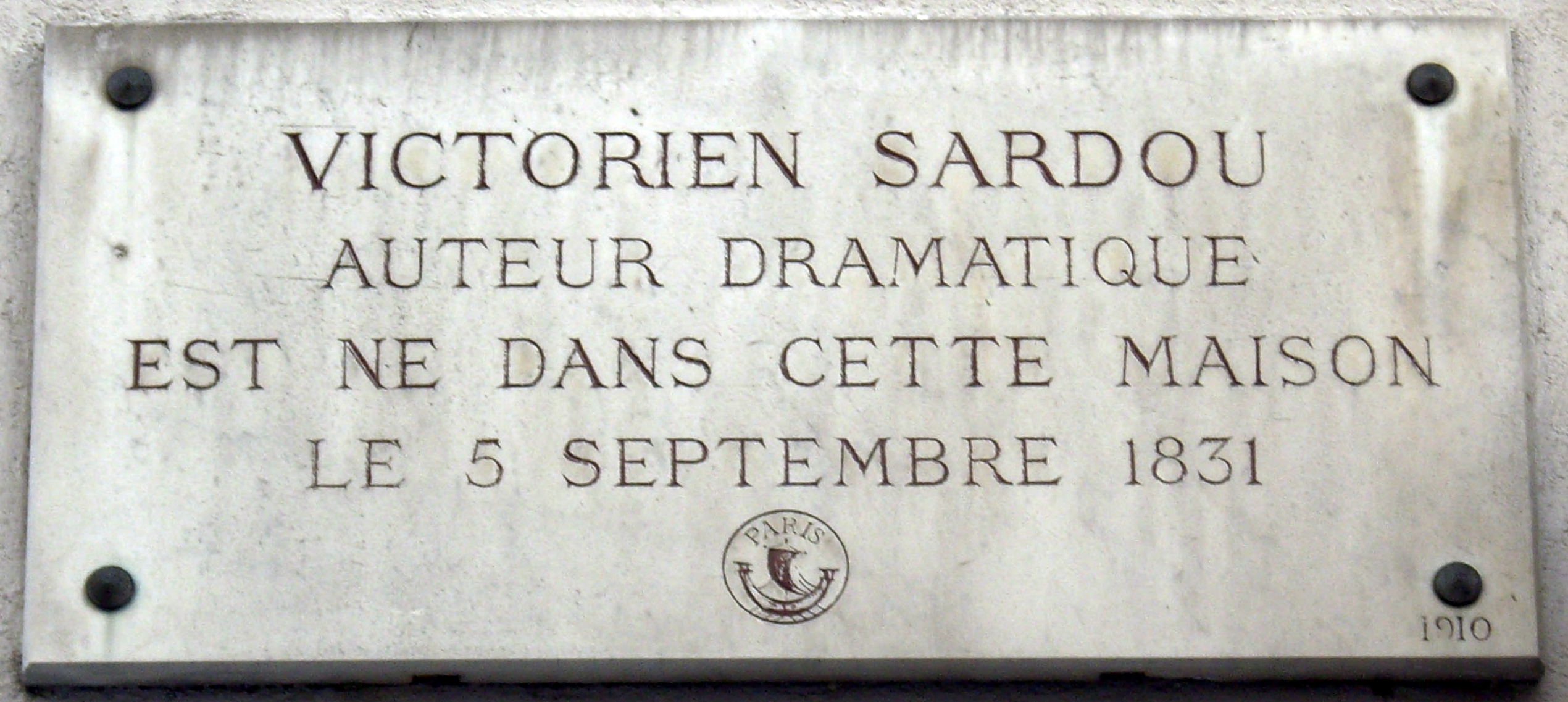|
Ganache
Ganache (; ) is a glaze, icing, sauce, or filling for pastries, made from chocolate and cream. Preparation Ganache is a chocolate preparation, normally made by heating equal parts by weight of cream and chopped chocolate, warming the cream first, then pouring it over the chocolate. The mixture is then typically left to rest for a short period (between 3 and 10 minutes generally, dependent on volume) before it is stirred or blended until smooth, with liqueurs or extracts added if desired. The resting period allows the hot cream to increase the temperature of the bowl and its contents. If one were to blend immediately this would introduce air reducing the temperature and preventing the chocolate from melting consistently. Butter is generally added to give the ganache a shiny appearance and smooth texture. Adding corn syrup also gives it a shiny color and is used to sweeten the ganache without the crystallization side effect that comes from other sugars. Depending on the kind of ... [...More Info...] [...Related Items...] OR: [Wikipedia] [Google] [Baidu] |
Chocolate Truffle
A chocolate truffle is a type of chocolate confectionery, traditionally made with a chocolate ganache centre coated in chocolate, cocoa powder, coconut, or chopped and toasted nuts (typically hazelnuts or almonds), usually in a spherical, conical, or curved shape. Their name derives from their similar appearance to truffles, edible fungi of the genus ''Tuber''. Varieties Major types of chocolate truffle include: *The Swiss truffle, made by combining melted chocolate into a boiling mixture of dairy cream and butter, which is poured into molds to set before sprinkling with cocoa powder. Like the French truffles, these have a very short shelf life and must be consumed within a few days of making. *The French truffle, made with fresh cream and chocolate, and then rolled in cocoa or nut powder. *The Spanish truffle, prepared with dark chocolate, condensed milk, rum (or any preferred liqueur), and chocolate sprinkles. *The typical European truffle, made with syrup and a base of c ... [...More Info...] [...Related Items...] OR: [Wikipedia] [Google] [Baidu] |
Cream
Cream is a dairy product composed of the higher-fat layer skimmed from the top of milk before homogenization. In un-homogenized milk, the fat, which is less dense, eventually rises to the top. In the industrial production of cream, this process is accelerated by using centrifuges called " separators". In many countries, it is sold in several grades depending on the total butterfat content. It can be dried to a powder for shipment to distant markets, and contains high levels of saturated fat. Cream skimmed from milk may be called "sweet cream" to distinguish it from cream skimmed from whey, a by-product of cheese-making. Whey cream has a lower fat content and tastes more salty, tangy and "cheesy". In many countries partially fermented cream is also sold: sour cream, crème fraîche, and so on. Both forms have many culinary uses in both sweet and savoury dishes. Cream produced by cattle (particularly Jersey cattle) grazing on natural pasture often contains some carotenoi ... [...More Info...] [...Related Items...] OR: [Wikipedia] [Google] [Baidu] |
Pâté
''Pâté'' ( , , ) is a paste, pie or loaf filled with a forcemeat. Common forcemeats include ground meat from pork, poultry, fish or beef; fat, vegetables, herbs, spices and either wine or brandy (often cognac or armagnac). It is often served on or with bread or crackers. Pâté can be served either hot or cold, but it is considered to develop its best flavors after a few days of chilling. History Pâté is believed to have originated in medieval France. The word pâté derives from the Old French word patete, which referred to any sort of paste. It was used to refer to the filling of any sort of pastry. Pâté is believed to have developed as a means of preserving the meat of game that could not be kept fresh. In the 16th century, it became popular with French royalty, and in the 17th century, the first recorded pâtés appeared. The first pâtés were made from a mixture of beef and chicken with various spices. By the 19th century, pâté was a staple in French cuisin ... [...More Info...] [...Related Items...] OR: [Wikipedia] [Google] [Baidu] |
Food Ingredients
Food is any substance consumed by an organism for nutritional support. Food is usually of plant, animal, or fungal origin, and contains essential nutrients, such as carbohydrates, fats, proteins, vitamins, or minerals. The substance is ingested by an organism and assimilated by the organism's cells to provide energy, maintain life, or stimulate growth. Different species of animals have different feeding behaviours that satisfy the needs of their unique metabolisms, often evolved to fill a specific ecological niche within specific geographical contexts. Omnivorous humans are highly adaptable and have adapted to obtain food in many different ecosystems. The majority of the food energy required is supplied by the industrial food industry, which produces food with intensive agriculture and distributes it through complex food processing and food distribution systems. This system of conventional agriculture relies heavily on fossil fuels, which means that the food and agr ... [...More Info...] [...Related Items...] OR: [Wikipedia] [Google] [Baidu] |
Enrobing
An enrober is a machine used in the confectionery industry to coat a food item with a coating medium, typically chocolate. Foods that are coated by enrobers include nuts, ice cream, toffee, chocolate bars, biscuits and cookies. Enrobing with chocolate extends a confection's shelf life. The enrober machine was invented in France in 1903, brought to the United States, and perfected to perform the work of at least twenty people. The process of enrobing involves placing the items on the enrober's feed band, which may consist of a wire mesh or containers in which the confection to be enrobed are placed, with each container having drain holes to recover excess chocolate. The enrober maintains the coating medium at a controlled constant temperature and pumps the medium into a flow pan. The medium flows from the flow pan in a continuous curtain and bottoming bed that the food items pass through, completely coating them. A wire mesh conveyor belt then transports the coated confection to a ... [...More Info...] [...Related Items...] OR: [Wikipedia] [Google] [Baidu] |
Fudge
Fudge is a type of confection that is made by mixing sugar, butter and milk, heating it to the soft-ball stage at , and then beating the mixture while it cools so that it acquires a smooth, creamy consistency. In texture, this crystalline candy falls in between fondant icing and hard caramels. Fruits, nuts, chocolate, caramel, candies, sweets, and other flavors are sometimes added inside or on top. Fudge is often bought as a gift from a gift shop in tourist areas and attractions. History Fudge originated in the US during the late 19th century. The term fudge is said to have come in the 17th century from the interjection fadge, meaning “to fit together in a clumsy manner” and was originally used as a verb. Recipes were printed in many periodicals and advertisements during the 1880s. Its popularity was partly due to the decreasing cost of refined white sugar and partly due to the ability to make it at home without special equipment. Its inexpensive, unrefined qual ... [...More Info...] [...Related Items...] OR: [Wikipedia] [Google] [Baidu] |
Peanut Butter
Peanut butter is a food paste or spread made from ground, dry-roasted peanuts. It commonly contains additional ingredients that modify the taste or texture, such as salt, sweeteners, or emulsifiers. Peanut butter is consumed in many countries. The United States is a leading exporter of peanut butter and one of the largest consumers of peanut butter annually per capita. January 24 is National Peanut Butter Day in the United States. Peanut butter is a nutrient-rich food containing high levels of protein, several vitamins, and dietary minerals. It is typically served as a spread on bread, toast, or crackers, and used to make sandwiches (notably the peanut butter and jelly sandwich). It is also used in a number of List of breakfast dishes, breakfast dishes and List of desserts, desserts, such as granola, smoothies, crepes, cookies, Chocolate brownie, brownies, or croissants. It is similar to other nut butters such as cashew butter and almond butter. History The earliest ... [...More Info...] [...Related Items...] OR: [Wikipedia] [Google] [Baidu] |
Hamlyn (publishers)
Hamlyn is a UK publishing company founded by Paul Hamlyn in 1950 with an initial investment of £350. His desire was to create "fine books with the common touch" which remains the foundation of its commercial success. It is part of the Octopus Publishing Group, now owned by Hachette Livre. History Paul Hamlyn sold the company to the International Publishing Company (now Time Inc. UK) in 1964, but stayed on until 1969. In 1964 Hamlyn commenced in Australia under the management of Kevin Weldon. It owned an interest in the Australian independent paperback publisher Sun Books from 1968 until 1971 when Macmillan Australia acquired that company. Paul Hamlyn bought the company back in 1986 and added it to the holdings of his new company, Octopus Books. Octopus was sold in 1987 to Reed International. Hamlyn's children's division was sold to the Egmont Group in 1998. Hachette Livre bought Octopus in 2001. Hamlyn is an international publisher of non-fiction Nonfiction, or non-f ... [...More Info...] [...Related Items...] OR: [Wikipedia] [Google] [Baidu] |
Larousse Gastronomique
' () is an encyclopedia of gastronomy. The majority of the book is about French cuisine, and contains recipes for French dishes and cooking techniques. The first edition included few non-French dishes and ingredients; later editions include many more. The book was originally published by Éditions Larousse in Paris in 1938. Background The first edition (1938) was edited by Prosper Montagné, with the collaboration of Dr Alfred Gottschalk, with prefaces by each of author-chefs Georges Auguste Escoffier and Philéas Gilbert (1857-1942). Gilbert was a collaborator in the creation of this book as well as ''Le Guide Culinaire'' (1903) with Escoffier, leading to some cross-over with the two books. It caused Escoffier to note when he was asked to write the preface that he could "see with my own eyes," and "Montagné cannot hide from me the fact that he has used ''Le Guide'' as a basis for his new book, and certainly used numerous recipes." The third English edition (2001), which run ... [...More Info...] [...Related Items...] OR: [Wikipedia] [Google] [Baidu] |
Oxford English Dictionary
The ''Oxford English Dictionary'' (''OED'') is the first and foundational historical dictionary of the English language, published by Oxford University Press (OUP). It traces the historical development of the English language, providing a comprehensive resource to scholars and academic researchers, as well as describing usage in its many variations throughout the world. Work began on the dictionary in 1857, but it was only in 1884 that it began to be published in unbound fascicles as work continued on the project, under the name of ''A New English Dictionary on Historical Principles; Founded Mainly on the Materials Collected by The Philological Society''. In 1895, the title ''The Oxford English Dictionary'' was first used unofficially on the covers of the series, and in 1928 the full dictionary was republished in 10 bound volumes. In 1933, the title ''The Oxford English Dictionary'' fully replaced the former name in all occurrences in its reprinting as 12 volumes with a one- ... [...More Info...] [...Related Items...] OR: [Wikipedia] [Google] [Baidu] |
Victorien Sardou
Victorien Sardou ( , ; 5 September 18318 November 1908) was a French dramatist. He is best remembered today for his development, along with Eugène Scribe, of the well-made play. He also wrote several plays that were made into popular 19th-century operas such as '' La Tosca'' (1887) on which Giacomo Puccini's opera ''Tosca'' (1900) is based, and '' Fédora'' (1882) and '' Madame Sans-Gêne'' (1893) that provided the subjects for the lyrical dramas ''Fedora'' (1898) and '' Madame Sans-Gêne'' (1915) by Umberto Giordano. His play ''Gismonda'', from 1894, was also adapted into an opera of the same name by Henry Février. Early years Victorien Sardou was born at 16 rue Beautreillis (), Paris on 5 September 1831. The Sardous were settled at Le Cannet, a village near Cannes, where they owned an estate, planted with olive trees. A night's frost killed all the trees and the family was ruined. Victorien's father, Antoine Léandre Sardou, came to Paris in search of employment. He was in ... [...More Info...] [...Related Items...] OR: [Wikipedia] [Google] [Baidu] |
Vaudeville
Vaudeville (; ) is a theatrical genre of variety entertainment born in France at the end of the 19th century. A vaudeville was originally a comedy without psychological or moral intentions, based on a comical situation: a dramatic composition or light poetry, interspersed with songs or ballets. It became popular in the United States and Canada from the early 1880s until the early 1930s, but the idea of vaudeville's theatre changed radically from its French antecedent. In some ways analogous to music hall from Victorian Britain, a typical North American vaudeville performance was made up of a series of separate, unrelated acts grouped together on a common bill. Types of acts have included popular and classical musicians, singers, dancers, comedians, trained animals, magicians, ventriloquists, strongmen, female and male impersonators, acrobats, clowns, illustrated songs, jugglers, one-act plays or scenes from plays, athletes, lecturing celebrities, minstrels, and ... [...More Info...] [...Related Items...] OR: [Wikipedia] [Google] [Baidu] |






